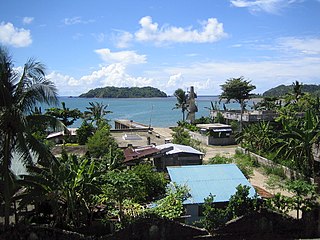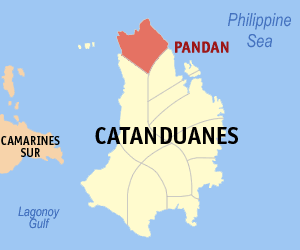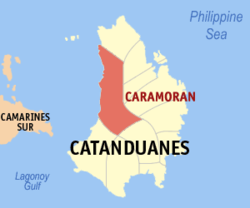
Catanduanes is an island province located in the Bicol Region of Luzon in the Philippines. It is the 12th-largest Island in the Philippines. Its capital is Virac and the province lies to the east of Camarines Sur across Maqueda Channel. It had a population of 260,964 people as registered in the 2015 census.

Virac, officially the Municipality of Virac, is a 1st class municipality and capital of the province of Catanduanes, Philippines. According to the 2015 census, it has a population of 73,650 people.

Bagamanoc, officially the Municipality of Bagamanoc, is a 5th class municipality in the province of Catanduanes, Philippines. According to the 2015 census, it has a population of 11,551 people.

Bato, officially the Municipality of Bato, is a 5th class municipality in the province of Catanduanes, Philippines. According to the 2015 census, it has a population of 21,279 people.

Gigmoto, officially the Municipality of Gigmoto, is a 5th class municipality in the province of Catanduanes, Philippines. According to the 2015 census, it has a population of 8,368 people.

Pandan, officially the Municipality of Pandan, is a 4th class municipality in the province of Catanduanes, Philippines. According to the 2015 census, it has a population of 20,516 people.

Panganiban, officially the Municipality of Panganiban, is a 5th class municipality in the province of Catanduanes, Philippines. According to the 2015 census, it has a population of 9,287 people.

San Andres, officially the Municipality of San Andres, is a 3rd class municipality in the province of Catanduanes, Philippines. According to the 2015 census, it has a population of 36,779 people.

San Miguel, officially the Municipality of San Miguel, is a 5th class municipality in the province of Catanduanes, Philippines. According to the 2015 census, it has a population of 15,006 people.

Viga, officially the Municipality of Viga, is a 4th class municipality in the province of Catanduanes, Philippines. According to the 2015 census, it has a population of 21,624 people.

Castilla, officially the Municipality of Castilla, is a 3rd class municipality in the province of Sorsogon, Philippines. According to the 2007 census, it has a population of 49,407 people.

Caramoan, officially the Municipality of Caramoan, is a 2nd class municipality in the province of Camarines Sur, Philippines. According to the 2015 census, it has a population of 47,605 people.

Lagonoy, officially the Municipality of Lagonoy, is a 2nd class municipality in the province of Camarines Sur, Philippines. According to the 2015 census, it has a population of 55,465 people.

Barangay San José or most commonly known as Barangay Oco is one of the thirty-one (31) barangays and among the two (2) urbanized barangays of Viga in the province of Catanduanes, Philippines. It lies for about 43 kilometres (27 mi) away from the Provincial Capital Virac, 3.5 kilometres (2.2 mi) from town proper of Viga and with the distance of 16 kilometres (9.9 mi) to the nearby town of San Miguel. According to the latest census, it has a population of 1,163 inhabitants. In August 2015 census, the population grew +0.33% from 1,163 to 1,183 inhabitants.
Burgos is one of the thirty-one (31) barangays of Viga in the province of Catanduanes, Philippines. It lies about 52 kilometers from the provincial capital Virac and 4.5 kilometers from town proper of Viga. According to the latest census, it has a population of 962 inhabitants, making it ranked as 7th largest barangay in Viga Municipality when it comes to population.
Rizal is one of the thirty-one (31) barangays of Viga in the province of Catanduanes, Philippines. It lies about 14 kilometers from the provincial capital Virac and 1 kilometer from town proper of Viga. According to the latest census, it has a population of 1,274 inhabitants, but still the largest barangay in Viga Municipality when it comes to population.
Pedro Vera, also known as P. Vera (Summit) is one of the thirty-one (31) barangays of Viga in the province of Catanduanes, Philippines. It lies about 6 kilometers from the provincial capital Virac and 5 kilometers from town proper of Viga. According to the latest census, it has a population of 1,248 inhabitants, making it ranked as 2nd largest barangay in Viga Municipality when it comes to population.
Tambongon is one of the thirty-one (31) barangays of Viga in the province of Catanduanes, Philippines. It lies about 15 kilometers from the provincial capital Virac and 6 kilometers from town proper of Viga. According to the latest census, it has a population of 1,190 inhabitants, making it ranked as 3rd largest barangay in Viga Municipality when it comes to population.
Tinago is one of the thirty-one (31) barangays of Viga in the province of Catanduanes, Philippines. It lies about 17 kilometers from the provincial capital Virac and 7 kilometers from town proper of Viga. According to the latest census, it has a population of 1,058 inhabitants ,but still ranked as 5th largest barangay in Viga Municipality when it comes to population.
Ogbong is one of the thirty-one (31) barangays of Viga in the province of Catanduanes, Philippines. It lies about 13 kilometers away from the provincial capital Virac and 5 kilometers from town proper of Viga. According to the latest census, it has a population of 1,006 inhabitants, making it ranked as 6th largest barangay in Viga Municipality when it comes to population.
















